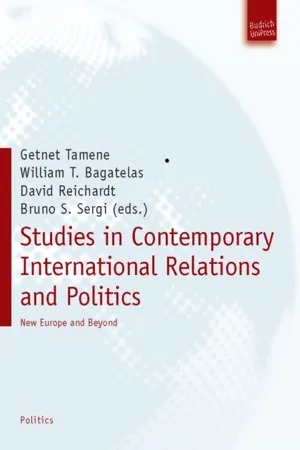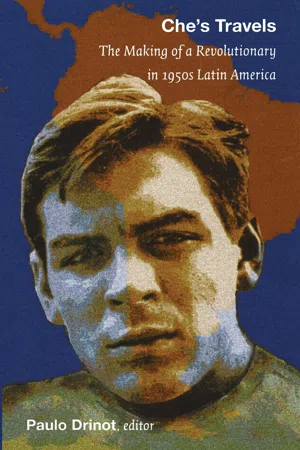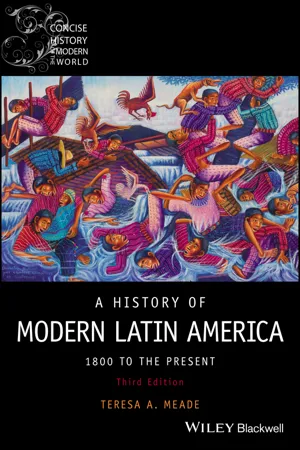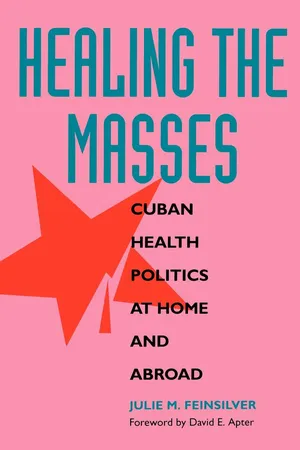Politics & International Relations
Che Guevara
Che Guevara was an Argentine Marxist revolutionary who played a key role in the Cuban Revolution alongside Fidel Castro. He became a symbol of anti-imperialism and revolution, advocating for armed struggle to overthrow capitalist regimes. Guevara's legacy extends beyond his political activities, as his image has been widely used as a symbol of rebellion and social justice.
Written by Perlego with AI-assistance
Related key terms
1 of 5
6 Key excerpts on "Che Guevara"
- Available until 15 Jan |Learn more
Studies in International Relations and Politics
New Europe and Beyond
- William T. Bagatelas, Getnet Tamene, David Reichardt, Bruno Sergi, William T. Bagatelas, Getnet Tamene, David Reichardt, Bruno Sergi(Authors)
- 2010(Publication Date)
- Budrich UniPress(Publisher)
Che would still be remembered in the hearts of a number of Third world elites; because this was the world, which was directly affected. Comparably, a large number of elites of the so-called developed world, enjoy a conformist position coloured with ambiguity and deception in favour of own narrow interest and personal achievement; this has rather triggered corruption and public discontent”. Conclusion: An Example not an Icon Che Guevara is an immense political figure in the history of Latin America and of the second part of the 20 th Century. He took part in Cuba in a revolutionary war that saw off a dictatorship and stood up to the might of US imperialism. His methods were primarily military, both in his achievements as a guerrilla leader (obviously) but also in his role in Castro‘s Cuba. Militarily the foco has subsequently proved to be a failure, as indeed it was already proving in South and Central America when Che left for the Congo and Bolivia. The victory in Cuba in 1959 has not been widely repeated. The Cuban regime itself has survived almost 50 years as a thorn in the flesh of the USA, a beacon of defiance and independence in America. As such it demands the support of all who fight imperialism. However, its early social reforms have not been matched by its growth into a political example for socialists throughout the world. Its isolation lead to a pattern of economic and political dependency on the Soviet Union. The Cuban state does not offer a model of vibrant workers’ democracy to be followed and developed into a socialism for the 21 st Century. It is ironic indeed that Che has been used most recently by the Cuban regime as an example of self-sacrifice and commitment to the existing order after the collapse of Cuba’s foreign backers and the increased penetration of market forces into Cuba. However, Che Guevara died a hero to revolutionaries in Latin America and other countries of the Third World and to millions in the metropolitan countries. - eBook - ePub
Viva Che!
The Strange Death and Life of Che Guevara
- Andrew Sinclair(Author)
- 2006(Publication Date)
- The History Press(Publisher)
Many intellectuals like myself have splendid ideas, but not all intellectuals have either the moral strength or the physical courage to put their ideas into practice. Che Guevara had this strength and that is why he will go down in history as a great man. He was the link between the Cuban Revolution in action and the revolution over the whole Latin American continent. Cuba can justly feel proud of Che’s internationalism, which was the living embodiment of the revolutionary doctrine.Some ideas are greater than men, but some men are as great as their ideas. I don’t just say this because I believe it is true, but because Che Guevara has proved that it is true. FRANCESCO ROSI (Italy) EPITAPH TO BE PLACED ON A MAP OF AMERICA Here lies Ernesto Guevara; they buried him in a box of earth and fear and they covered it up with the skyless night of the forest. This tomb is in the jagged shape of a map of America: it is trodden by the bare feet of those who bear the shackles of poverty round their ankles and who wear the truth like a grimy halo.He was a hero and an artist, because an artist is a man who transcends his creation, and a hero’s work of art is that last gesture of his life in which he gives up his life in order to kill his death.At that instant, the idea becomes the ideal, and the ideal then transcends the cold logic of intelligence to attain the mysterious realm of aesthetics; it is there that the ideal becomes one with flesh, becomes one with pain and with fear, and takes on the shape of the act that called it into existence. Thus heroism and art are fused into one and the same thing.In warfare, Guevara was a humanist; for armed struggle only meant one thing to him: that gesture which America is beginning to make, that gesture of picking up a rifle in battle, a rifle that turns the hand which holds it into a clenched fist.DALMIRO SAENZ (Argentina)Che Guevara’s life is the finest example of Caribbean-American revolutionary heroism I know; the news of his death, the most humbling and numbing I have experienced, is similar in personal loss to a death in one’s own family. His legendary life and tragic death are as much mine, and ours, as they are gloriously his; his life’s work and its terrible termination are a revolutionary whole. How acceptable Sartre’s rhetoric sounds, now, a matter of months after Che’s assassination: ‘(He) was not only an intellectual but also the most complete human being of our age.’ - eBook - PDF
Che's Travels
The Making of a Revolutionary in 1950s Latin America
- Paulo Drinot(Author)
- 2010(Publication Date)
- Duke University Press Books(Publisher)
Thus ‘‘Che is not a historical exception but the realization of the historical aspirations of the continent and the world. In him are expressed the struggles of the past and the victories of the future.’’ ππ What politi-cian could resist associating himself with such a revered icon? In 2004 Guevara’s daughter, Aleida Guevara, conducted an extended interview with Chávez that subsequently became a book, a dvd , and the subject of a documentary. π∫ Caracas venders sold a T-shirt in 2006 with the slogan ‘‘the four fantastic revolutionaries’’; it bore the images of Bolívar, Chávez, Guevara, and Fidel Castro. A subliminal message is that if one rejects Chávez one also rejects Bolívar, Gue-vara, and perhaps even Christ. Chávez has also pleased the followers of the María Lionza religion by ensuring that the famous Colina statue was restored after it collapsed beside the freeway in 2004. The original statue will now reside in the Plaza Bolívar of the Univer-sidad Central, while a replica will su√er the noxious fumes of the highway. In the battle between good and evil, Chávez aligns himself with the moral, and revolutionary, spirits. ∞π∏ Judith Ewell Many Venezuelans criticized Guevara’s foco theory, but few have objected to his rather saintly mythological image. One who did was the former mas presidential candidate José Vicente Rangel in an interview in 1978. Rangel has held various prominent positions in the Chávez governments including that of vice president and for-eign minister, and he might express himself di√erently today. Thirty years ago, however, Rangel said that he had a profound respect for Guevara but that he considered the growth of the Che myth unhealthy. If we emphasize exclusively the heroic aspect of one who sacrifices his life, we gravely damage the revolutionary movement, because we teach the young to become accustomed to the idea that revolution is brilliance, heroism, audacious action. - eBook - PDF
A History of Modern Latin America
1800 to the Present
- Teresa A. Meade(Author)
- 2022(Publication Date)
- Wiley-Blackwell(Publisher)
Since Korda’s death in 2001, there has been no one to object to any use of the Che image, capitalist, socialist, or otherwise. Nonetheless, despite its widespread reproduction on every product imaginable, Che’s face yet persists as one of the most famous international revolutionary icons. 251 CUBA: GUERRILLAS TAKE POWER El Che, as he was known, set out to reproduce the guerrilla movement’s triumph, first in the African Congo and later in the mountains of Bolivia. Drawing on French philosopher Régis Debray’s (b. 1940) guerrilla warfare strategy, which he termed focoismo, Che argued that the Latin American hemisphere was ripe for socialist revolu- tion, that the conditions for a socialist insurrection could be accelerated by a small band of armed militants drawn tightly together under disciplined leadership. Instead of opting for the clandestine armed struggle as a last resort, when conditions prohib- ited an above-ground movement, the foco formula envisioned the opposite: the emergence and proliferation of mass organizations as a result of armed actions by a covert revolutionary cadre. In this regard Che’s view broke decisively with – rather than simply ignoring, as had been the strategy of Cuba’s 26th of July Movement – the Moscow-oriented Latin American communist parties and with the conventional wisdom of Marxist-Leninist theory. Guevara chose the Bolivian Altiplano to test this theory, bringing together a tightly knit group of Cubans, an East German woman with the code name Tania, and a few urban-based Bolivian and Peruvian communists. The plan failed miserably. In 1967 Bolivian rangers, trained and supplied by the US Special Forces, captured, executed, and buried Guevara in an unknown grave, after sending to the press a photo of his tortured and emaciated body. - eBook - PDF
The Semiotics of Che Guevara
Affective Gateways
- Maria-Carolina Cambre(Author)
- 2014(Publication Date)
- Bloomsbury Academic(Publisher)
Across the globe, other people resonate in similar ways with the Guerrillero Heroico . It appears and reappears, sometimes as a two-tone picture, occasionally as a drawing, but always evoking, if not reproducing, the unforgettable expression on Che Guevara’s face. Many times the image is simply being exploited as designer revolutionary-ism for trendy popular consumption; however, it repeatedly emerges in the midst of social protests and demonstrations gazing out from placards and banners. 2 On the streets, people claim to walk in the footsteps of Guevara and his face seems to function trans-temporally and trans-nationally as a reminder of the connection between struggles near and far. Latin American intellectuals observe that Guevarismo is present as a resistance to the established order in certain social movements ( Löwy 1997, 2). In these contexts, just as much as in the 23 de enero, the meaning of the image is explicitly linked with Guevara’s ethical and political stance when people declare they will continue what he had begun. It surfaces in marches against N.A.T.O. in Istanbul, Bush in Berlin, privatization of education in Australia, for democratic rights in Sarajevo, and among illegal immigrants in the U.S.A. Although rebellion and resistance are common themes, it may be problematic to assume rebellion signifies the same thing to people regardless of time or place, or that perfect translation is possible. The moment of snapping the photograph was not in itself a rebellious one. On March 5, 1960, Che Guevara was unaware and photographer Alberto Diaz Gutierrez, later known as Korda, took the shot by chance: “This photograph is not the product of knowledge or technique. It was really coincidence, pure luck,” commented Korda ( Sridhar 2002, 5). The previous day, a bomb had killed sailors and stevedores on the French freighter La Coubre , carrying a Belgian arms shipment. Rescuers boarding the ship were killed by the detonation of a second bomb. - eBook - PDF
Healing the Masses
Cuban Health Politics at Home and Abroad
- Julie M. Feinsilver(Author)
- 2023(Publication Date)
- University of California Press(Publisher)
The conversion of barracks into schools symbolizes the moral superiority of the revolution to the previous capitalist regime of Batista. 4 " Cuba's CUBA ON THE WORLD STAGE 17 provision of civilian technical aid to other developing nations sym- bolizes Cuba's social development and technical capacity as well as its humanitarianism. Cuban revolutionary symbolism provides continuity between the present and Cuban and Latin American historical figures such as the Indian chief Hatuey, who fought the Spanish conquest; nineteenth- century Cuban independence leaders Antonio Maceo, Carlos Manuel de Céspedes, and José Martí; Simon Bolivar, the Latin American lib- erator; and Marx and Lenin. Thus those Cubans who defend the rev- olution and perform internationalist service are continuing in this tradition of fulfilling Cuba's duty {el deber cubano) to fight imperi- alism, colonialism, and capitalism. 41 Individuals too have come to symbolize revolutionary values. Che Guevara, one of the more important symbols of the revolution, rep- resents both the "new person" and internationalist solidarity. The Cubans who died during the invasion of Grenada are, according to Castro, symbols, not corpses. 42 And Castro himself has been seen in the past as a symbol of revolution and social justice by many in the Third World. Most important for my analysis is the notion that gains of the revolution are seen as symbolic of the contrast between social- ism and capitalism with aspects of U.S. society and dependent capitalist so- cieties symbolic of capitalism's inherent inequality and failure to provide Marti's goal, that is, "una vida de decoro" ("a life of dignity"). 41 One therefore finds comparisons of life in the United States with that of Cuba in Castro's speeches and in the Cuban media.
Index pages curate the most relevant extracts from our library of academic textbooks. They’ve been created using an in-house natural language model (NLM), each adding context and meaning to key research topics.





